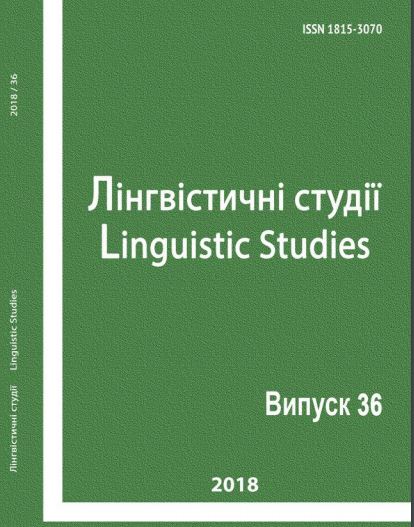Terms of Greek and Latin Origin in Ukrainian Mycological Vocabulary.
DOI:
https://doi.org/10.31558/1815-3070.2018.36.20Keywords:
mycological vocabulary, official names of fungi, the Ukrainian language, loanwords, Greek and LatinAbstract
Some lexical resources are characteristic of all types of analyzed sources. A large part of them, especially monographs and articles in the field of mycology (to a lesser extent, a dictionary or Internet resources), are characterized by a variety of mycological vocabulary, in particular, loan words. The article also investigates the official Ukrainian names of macroscopic fungi derived from Greek and Latin. The most frequent are names whose generic element was borrowed (from Greek, more often from Latin), and the species epithet was the Ukrainian name. Constructions whose species epithets were calques/partial calques, turned out to be quite productive.References
Gerd, Aleksandr. „Nauchno-Tekhnicheskaya Lexikografiya”. Prikladnoye Yazikoznaniye, Sankt- Peterburg: Izdatel’stvo Sankt- Peterburgskogo Gosudarstvennogo Universiteta. 1996, p. 292-294. Print.
Jóźwikiewicz, Przemysław. „Z problematyki nazewnictwa grzybów wielkoowocnikowych w języku ukraińskim i polskim – przegląd źródeł”. (Оn theTerminology of Macrofungi in Ukrainian and Polish - an Overview of Sources). Slavica Wratislaviensia CLXV, Wrocław: Wydawnictwo Uniwersytetu Wrocławskiego 2017, s. 169-178. Print.
Kurylenko, Volodymyr. “Hryby – Huby: Polisemiya chy Omonimiya? (na Materiali Leksyky Polis’kykh Hovoriv)” (Fungi – Polypores: Polysemy or Homonymy? (Based on the Polisky Dialects)). Zapysky z Ukrayins’koho Movoznavstva 16 (2006): 219-223. Print.
Omel’kovets’, Ruslana. „Mikolohichna leksyka zakhidnopolis’kykh hovirok”. Sovremennyye Napravleniya Teoreticheskikh i Prikladnykh Issledovaniy ʽ2013: Materialy Mezhdunarodnoy Nauchno-Prakticheskoy Konferentsii, Odessa 2013, Т. 23, p. 91-97. Print.
Omelkovets’, Ruslana. „Semantychna Transphormatsiya yak Sposib Nominatsiyi Mikoobyektiv u Zakhidnopolis’kykh Hovirkakh” (Semantic transformation as a way of nomination of microobjects of the zakhinopolisky dialects). Typolohiya ta Funktsiyi Movnykh Odynyts’ 1 (2014): 231–239. Print.
Prus, Valentyna. «U Netryakh Prokydayut’sya Hryby. Mahichnyy Znak - po Vid’mynomu Kolu.» (Etnolinhvistychnyy Aspekt Polis’koho Zbyral’nytstva). Volyn’-Zhytomyrshchyna. Istoryko-filolohichnyy zbirnyk z rehional’nykh problem (6). 2001, p. 151-153. Print.
Sabadosh, Ivan. „Yak Zvut’sya Hryby?”. (…). Kul’tura slova Vyp. 34, redkol. M. M. Pylyns’kyy [ta in.], Kyiv: Naukova dumka, 1988, p. 21-22. Print.
Sabadosh, Ivan. Istoriya Ukrayins’koyi Botanichnoyi Leksyky, Uzhhorod: Uzhhorods’kyy Natsional’nyy Universytet 2014, p. 495-513. Print.
Symonenko, Larysa. „Synonimichni Nazvy Hrybiv v Ukrayins’kiy Movi” (Synonymous of the Names of Fungi in the Ukrainian Language). Ridne Slovo 7 (1973): 23-26. Print.
Symonenko, Larysa. Mikolohichna Leksyka Ukrayins’koyi Movy: Dys. … kand. filol. nauk, Kyiv 1973, 218 pp. Symonenko, Larysa. „Yak Nazvaty Hryby” (How to call fungi?). Ridne Slovo 9 (1974): 38-41. Print.
Tkachuk, Maryna. „Mikonominatsiya v Chornobyl’s’kykh Hovirkakh (Pytannya Rekonstruktsiyi Arealu)” (Myconomination in the Chernobyl Dialects (question of the reconstruction of the area)). Volyn’ – Zhytomyrshchyna 22 (2) (2010): 275-282. Print.
Zerova, Mariya, and Pavlo Sosin, and Halyna Rozhenko ta in. Vyznachnyk Hrybiv Ukrayiny. Kyiv: Naukova Dumka. 1967-79. Print.


